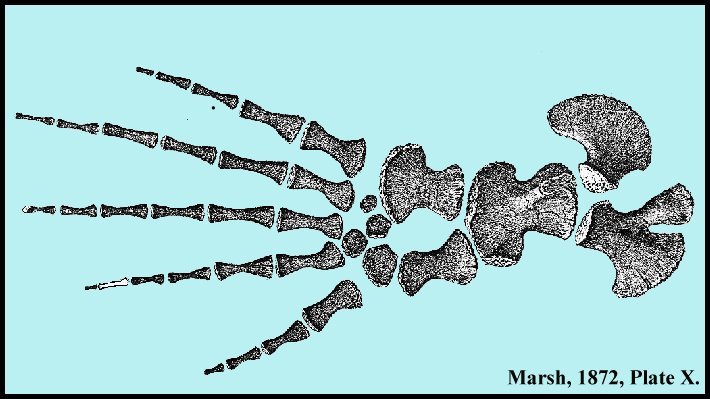| 140
PROCEEDINGS OF THE ACADEMY OF __________
JUNE 11.
The President, Dr. RUSCHENBERGER, in the chair.
Twenty-five members present.
Prof. COPE offered some remarks on the
discoveries recently made by Prof. Marsh as to the structure and characters of the
Pythonomorpha, based especially on material recently obtained by him in Kansas. As the
writer had recently passed in review much similar material, he was much interested in
Prof. Marsh's conclusions. These, he said, were of importance. In the first place, he had
ascertained that what was formerly supposed to be the inner side of the quadrate bone was
the outer side, a conclusion Prof. Cope thought entirely consistent with the other known
relations of the parts.
Secondly. He had discovered the stapes, and had
entirely confirmed the opinion of the speaker, which Prof. Marsh had apparently
overlooked. This was stated as follows:1 the quadrate "is characterized by
the presence of an oval pit. ... Its use is uncertain, but there is some probability that
it received the extremity of an osseous or cartilaginous styloid stapes. A groove on the
under side of the suspensorium, would accommodate such a rod, and in a position nearly
similar to that which it occupies in many of the Ophidia." It is in precisely this
position that Prof. Marsh is so fortunate as to have discovered it.
Thirdly. Prof. Marsh believes that he has found the
columnella. I have supposed it to be wanting, from the absence of its usual points of
attachment on the parietal and pterygoid bones. It remains to compare the bone found by
Prof. Marsh with ali- and orbito-sphenoid and ethmoid ossifications found in many
saurians.
Fourthly. Prof. Marsh has observed the
parieto-quadrate arch described by the speaker, and makes the interesting observation that
it is formed of three elements, the median connecting the parietal with the opisthotic.
This piece, he says, is "apparently the squamosal; "as the latter bone completes
the zygomatic arch, it cannot occupy a position in the parieto-squamosal, unless it sends
a branch in that direction.
Fifthly. He discovers the malar arch, proving it to be
incomplete and supported by the postfrontal bone. Prof. Marsh also observes an
ossification in the glenoid cavity of the opisthotic, which he regards as the pterotic (of
"Huxley," which should be Parker),
1 Trans. Amer. Philos. Soc., 1869, p. 180.
|
NATURAL SCIENCES OF PHILADELPHIA.
141 an
identification which cannot probably be maintained. The connections of the pterotic, where
present, are very different. The bone in question is present in Edestosaurus tortor,
Cope.
Sixthly. Prof. Marsh completes almost entirely our
knowledge of thee anterior limbs. The previous descriptions of these members in Clidastes
propython, Cope, Holcodus ictericus, Cope, and other species, had left the
number of phalanges and their relative positions, as well as those of the carpal,
uncertain; these points are now happily supplied by Prof. Marsh's important researches.
Seventhly. He has done much for the pelvic arch and
hind limbs. He was the first to announce the existence of both, and actually described the
pelvis of Edestosaurus dispar; the speaker, however, first described the hind
limb in Liodon crassartus and L. dyspelor, Cope. Prof. Marsh is in error
when he says the "absence of these extremities in the Pythonomorpha was considered
satisfactorily established." I had never stated that they were certainly absent, and
the last time I wrote observed that this order "possessed an anterior pair only, or
with the posterior pair so reduced as to have been insignificant."1 They
appear, according to Marsh, to have been relatively small in some of the genera.
In Liodon dyspelor, Cope, the anterior are
the smaller. Prof. Marsh lays students under especial obligation for his determinations of
the pelvic elements and the excellent figures of all the parts connected with the support
of the hind limb. His figure of the fore limb is also highly important, as it "will
be difficult soon to duplicate his beautifully complete specimen.
In subsequent pages there are six additional species described, bringing up the
number from the Kansas Cretaceous to twenty- three. Two new genera are proposed, viz., Lestosaurus
for those previously referred by myself to Holcodus, Gibbes, and Rhinosaurus
for species allied or belonging to Liodon. As to the former, it is no doubt a
well-marked genus, and I am willing to believe Prof. Marsh's opinion, that it will not
include Gibbes' Holcodus acutidens, will turn out to be well founded; but there
is, on the other hand, insufficient evidence to show that it is not Platecarpus,
Cope. If Liodon curtirostris be referred to it, it will very probably prove to be
Platecarpus, as that species presents palatine teeth, much as in P.
tympaniticus, and the pleurodont character is not wanting in some of the other
species. Rhinosaurus includes such species as Liodon proriger, Cope. As
the name has been used two or three times before, it may be altered to Rhamphosaurus,
but I have always had doubts that the conic projecting snout would distinguish the species
generically from the true Liodon, with which it agrees in dentition. The type of Liodon,
L. anceps, ord., is, however, very little known.
1 Hayden, Geol. Survey of Wyoming, etc., 1870,
p. 385.
|

